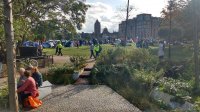Yes it is.
Section 12 and Section 14 of the Public Order Act 1986.
One deals with static protest, the other with processions/marches but other than that the wording/powers are the same.
Public Order Act 1986
Of course the question of what is meant by serious public disorder, serious damage to property or serious disruption to the life of the community is left vague and open. The act was orginally brought in as a response to the orange order marches in NI and to give police there the power to stop them going down particular roads or into particular areas, as this tended to result in riots.
Since then, power creep has happened, and now it's used for more or less any protest. The arrests of the critical mass cyclists who went to ride past the olympic stadium on the evening of the opening ceremony of the 2012 olympics were arrested under s14 powers.
It's important to note that you can only be arrested under s12/s14 if you are aware that an order has been put in place. It's important that you do not accept anything from police as they will try to hand you notices that the order is in place and if you take one, you make yourself liable to arrest. Similarly, if you hear one is in place don't put it on social media or tell anyone else.
Obviously the police can and will arrest you under the s12/s14 order even if you haven't heard anything of it but it makes it hard to charge you for the offence if they can't show you knew.










